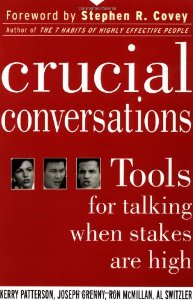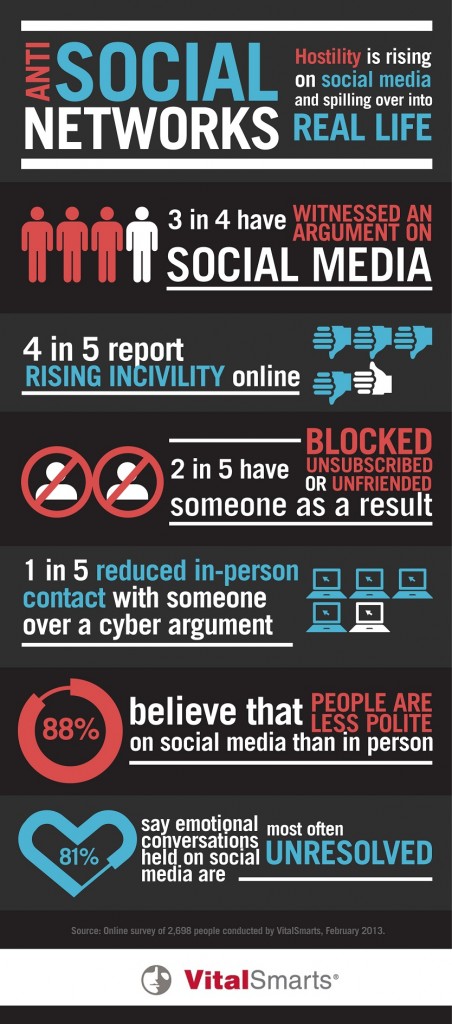Back in April I wrote an article about the ill-timed and extremely insensitive Tweets put forth by a brand: Epicurious Uses The Boston Marathon Tragedy To Cross That Line. It was of course not the first nor the last example of social media gone bad in the context of a brand and those entrusted with the marketing of it.
Today, however, I want to talk about when social media goes bad from a human perspective. You do remember humans, right? Oh sure, there’s autobots and other techno-related gizmos that will Tweet, post and Like on we humans’ behalf – at least I think there is?
But at the end of the day it is we humans who are traveling the highways and biways of social media on an ever-increasing pace.
And it is we humans, judging by the results of a recent study, who are leaning more and more on social media to air our dirty laundry; to hold grudges; to be, dare I say it: uncivilized.
Led by Joseph Grenny, co-author of the New York Times bestseller Crucial Conversations, the study revealed, among other things: nearly 4 in 5 people are seeing increased incivility on social media, and 2 in 5 have unfriended or blocked family, friends or coworkers as a result.
Additional findings include:
- 76 percent of respondents have witnessed an argument on social media
- 88 percent believe people are less polite on social media than in person
- 1 in 5 reduced in-person contact with someone over a cyber fight
[see the infographic below]
One of the survey respondents, Laura M., is still reeling from a family rift that began in cyberspace. It started innocently enough – her brother posted an embarrassing picture of her sister who asked him to remove it. A full-scale family brouhaha resulted when he not only refused to remove the photo, but instead blasted it out to his entire contact list. Ultimately, Laura’s brother unfriended all of his siblings and has denied in-person contact with them for the past two years and counting.
One of the most telling findings of the survey was the fact that younger people are four times more likely than Baby Boomers to prefer having these emotionally charged conversations over social media, so the need to learn to effectively communicate online is increasing.
This is telling for the simple reason we’re talking about our future leaders, business owners, and so on here. If someone who is say in their early 20s is unable to deal with an issue face-to-face and resorts to the perceived safer streets of social media – how will they be equipped to deal with these kinds of issues when they get older? And presumably have more responsibility both personally and professionally.
Take The Good With The Bad
There are many obvious good things when it comes to social media as Grenny puts it “Social media platforms allow us to connect with others and strengthen relationships in ways that weren’t possible before.”
I am living proof of that having met some truly incredible people I would have never met if it were not for social media.
But, as Grenny is quick to add “Sadly, they have also become the default forums for holding high-stakes conversations, blasting polarizing opinions and making statements with little regard for those within screen shot. We struggle to speak candidly and respectfully in person, let alone through a forum that allows no immediate feedback or the opportunity to see how our words will affect others.”
I had a chance to speak with Grenny as I was interested in learning more about the study and its findings.

SO: What was the biggest surprise that came out of the study?
JG: People widely report that crucial conversations held on social media most often go unresolved, and yet, we haven’t changed the way we communicate via this medium.
SO: What impact, if any does the study’s findings have on marketers & advertisers and/or those responsible for manning the respective social media accounts on behalf of companies, brands, etc?
JG: I don’t think the toxic exchanges people have on social media have many implications for marketers and advertisers per se. I suppose they should expect people to be more hostile in writing than they would be in face-to-face interaction, but that’s not new for those who staff 800 numbers or have received nasty letters for years.
SO: Do you think the findings are indicative in any way of a larger problem when it comes to social media?
JG: The findings are indicative of a progressive problem in communication in general. Manners have not kept pace with technology. We have a hard enough time holding crucial conversations face-to-face—when we have visual data about how our messages are being received. Since the invention of the telegraph, telephone, voice mail, email, texting and now social media—we have gotten progressively more distant from interpersonal cues but seem no less capable of dealing with sensitive issues in a skillful way.
SO: Are there too many social media networks which could potentially be adding to this problem?
JG: The number of social media networks isn’t the problem—the problem is twofold—1) a lack of social norms that guide us to stop conversations when the medium is the problem; and 2) a lack of skill in holding emotionally and politically risky conversations in general.
Grenny offers the following tips for communicating both candidly and respectfully on social media:
- Check your motives. Social media hasn’t only changed the way we communicate, it has modified our motives. Ask yourself, “Is my goal to get lots of Likes (or even provoke controversy)?” or “Do I want healthy dialogue?”
- Replace hot words. If your goal is to make a point rather than score a point, replace “hot” words that provoke offense with words that help others understand your position. For example, replace “that is idiotic” with “I disagree for the following reasons.”
- Pause to put emotions in check. Never post a comment when you¹re feeling emotionally triggered. Never! If you wait four hours you¹re likely to respond differently.
- Agree before you disagree. It’s fine to disagree, but don’t point out your disagreement until you acknowledge areas where you agree. Often, arguers agree on 80 percent of the topic but create a false sense of conflict when they spend all their time arguing over the other 20 percent.
- Trust your gut. When reading a response to your post and you feel the conversation is getting too emotional for an online exchange – you’re right! Stop. Take it offline. Or better yet, face-to-face.
Cover image source: Amazon
Named one of the Top 100 Influencers In Social Media (#41) by Social Technology Review and a Top 50 Social Media Blogger by Kred, Steve Olenski is a senior creative content strategist at Responsys, a leading global provider of on-demand email and cross-channel marketing solutions, and a member of the Editorial Board for the Journal of Digital & Social Media Marketing. He can be reached via Twitter, LinkedIn or Email.

